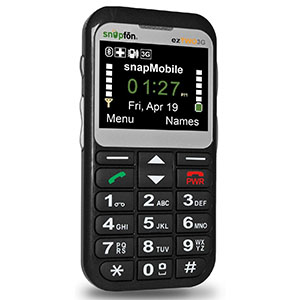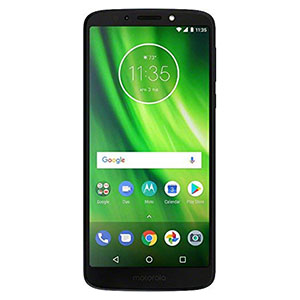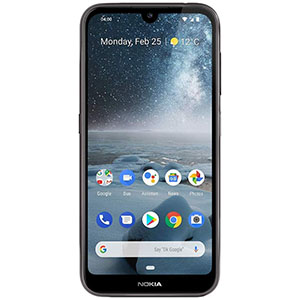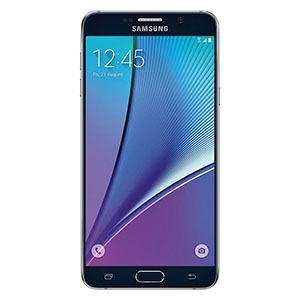Smartphones for seniors are designed to facilitate mobile phone use by older folks. What sets them apart from most standard smartphones is that they offer features that address issues such as poor eyesight, diminished hearing, arthritis and more.
To be sure, some standard smartphones have feature sets that also address the needs of seniors (Samsung’s ‘Easy Mode’ springs to mind). But for some seniors the typical smartphone setup and tendency toward app overload is simply too much. They crave clarity and simplicity above all else and there are, as you’ll see, companies ready to provide it for them.
The following is our list of the 10 best smartphones for seniors, updated for 2023.
Rankings
1. ASUS ZenFone Max Pro (M2)

Click here for the lowest price on Amazon
The ASUS ZenFone offers several features that should appeal to seniors. Those include the bigger-than-average screen and day-long battery use on a single full charge. At the same time it’s sufficiently powerful to integrate with other smart objects, play internet video and enable whatever apps you have in mind.
What we like: We appreciate the generous battery life and the large 6.3 inch screen. The speaker is also loud enough to satisfy most. We also like the 128 GB of memory, the contemporary profile and the fact that it will handle all your emergency apps.
Flaws: While the big screen makes it easy to read, view photos and more it also means the phone is larger than most. This may be an issue for some.
2. Nokia 6.1

Click here for the lowest price on Amazon
Nokia – once the dominant mobile phone maker – has seen its share of the market plummet in recent years. Nonetheless, they still manage to produce some interesting products. And if you are a senior looking for a smartphone to fulfill your unique requirements the 6.1 is worthy of your consideration.
What we like: We like the big, bright screen. We appreciate that the body is fashioned from a since piece of aluminum, making it very durable, and that the Gorilla Glass 3 is highly resistant to damage.
It’s also affordable, sharp-looking and and fully capable of streaming HD video from the net or handling stock trading apps without blinking an eye.
Flaws: Most people would conclude that the camera is not up to 2020 standards. It’s good. It’s just not leading edge stuff.
3. Samsung Galaxy S8 Smartphone

Click here for the lowest price on Amazon
The Galaxy S8 from Samsung earns a place on our list for its outstanding battery life, large screen and Samsung’s rightfully lauded ‘Easy Mode’. When engaged Easy Mode reconfigures the screen with fewer, larger icons and larger fonts. A big plus for seniors with less than perfect eyesight.
What we like: We like that there’s plenty of memory. We also appreciate the water-resistant shell that can be submerged for up to half an hour. The camera, while not top-of-the-line is more than adequate for the casual user. Finally, Easy Mode is a real boon for seniors and the 30 hour battery life is a big plus.
Flaws: The battery can take its time to recharge. And there’s no wi-fi calling. Should that be important to you or the person you’re buying for.
4. Snapfon ezTwo Senior Cell Phone

Click here for the lowest price on Amazon
The Snapfon ezTwo looks like it arrived via a wrinkle in the spacetime continuum. The makers of the ezTwo Senior Cell Phone looked to the past for inspiration and came up with a phone that’s easy to read, easy to hear, rugged and simple.
What we like: The phone is large enough to offer good sized, easy to read buttons. The fonts on the screen are also big and clear. The SOS button gets our attention for the right reasons and can be linked directly to local emergency services. The speaker is also plenty loud.
Flaws: Not a smartphone for surfing the net or taking photos. Also, the battery is nothing to write home about. And not everyone will embrace the retro look.
5. Motorola Moto G6 Play Factory Phone

Click here for the lowest price on Amazon
Motorola is another once robust brand that has seen its market share reduced to virtual ash in recent years. Yet their Moto G6 Play Factory Phone offers a lot that will appeal to older folks who want smartphone styling alongside features that will facilitate easy use.
What we like: As many seniors love to chat on the phone it’s hard to beat a battery that lasts all day. The screen is also nice and large and provides edge to edge coverage. You shouldn’t have any trouble running multiple apps with the quad core processor and the 128 GB of memory means you’ll never run out of space for pics.
Flaws: Not as fast as advertised. The screen might be a bit small for some seniors.
6. Samsung Galaxy Note 9

Click here for the lowest price on Amazon
Few are the young people who would equate the Samsung Galaxy Note 9 with senior citizens. But when it comes to buying a smartphone for their parents or grandparents the Note 9 should be on their list of phones to consider. If for no other reason than the company’s Easy Mode option that essentially eliminates barriers to use for seniors with diminished eyesight.
What we like: We love the 6.4 inch screen. Really allows you to see everything clearly when you employ Easy Mode. It also comes with a stylus you can use to navigate with and the all-day battery means the phone won’t go dead during dinner with friends.
Flaws: Definitely for seniors who are reasonably tech savvy and engaged and not those just looking for a phone to make the occasional call.
7. Jitterbug Smart2 No-Contract Smartphone

Click here for the lowest price on Amazon
Jitterbug phones are designed specifically to address the needs of older users. The Smart2 offers familiar smartphone design cues while at the same time conceding that lots of seniors need bigger fonts and simpler navigation. The Smart2 provides just that and does so without forcing seniors to accept expensive service contracts.
What we like: We like that the screen is large and easy to read. We like that you can bypass the keyboard and do voice texting (great for those with arthritis). We appreciate the shortcut to the emergency response system. And the 13 mp camera while not leading-edge is pretty good.
Flaws: Customer support is not going to win any awards. Which is why this isn’t higher on the list.
8. Nokia 4.2 – Android One

Click here for the lowest price on Amazon
Our second entry from Nokia is an affordable, easy to use smartphone that’s powerful enough to run whatever apps the user has in mind but not so complicated it will give them headaches. It puts Google Assistant front and center which makes it a good choice for those with arthritis or impaired vision.
What we like: We appreciate that this smartphone is actually affordable. And the fact that they’ve made Google Assistant such an upfront feature is a plus. The Adaptive Battery Mode enables you to glean optimal use from every charge. And the notification ring around the power button is handy for those with compromised hearing.
Flaws: You may run into compatibility issues with some apps. Also, the screen is pretty modest in size.
9. Jitterbug Flip

Click here for the lowest price on Amazon
The Jitterbug Flip Phone is not a true smartphone, but a mobile phone with everything scaled up and simplified to promote ease of use. Which is why it’s not higher on our list. That said, it does what it does really well and it provides an easy way for seniors to call their friends or summon emergency services should they need them.
What we like: This is a simple device for those who want simple, dependable functionality from their mobile phone. Everything is super easy to read, the speaker is loud and clear and there are no contracts involved. It also has Jitterbug’s dedicated emergency call button.
Flaws: It’s not a contemporary looking phone. And it doesn’t offer contemporary features like internet access.
10. Samsung Galaxy Note 5

Click here for the lowest price on Amazon
The Galaxy Note 5 and its stylus provide an attractive alternative to tapping out messages on a digital keyboard with your fingers. Especially if those fingers are beset by arthritis. The screen is also large, bright and clear and the camera is one of the best on our list. And, of course, Samsung’s Easy Mode is only a few taps away.
What we like: We like the big clear screen, 64 GB of storage, the quality camera and the uncluttered look. We also like the good to excellent battery life, the ability to run multiple apps at once and stylus, which makes a lot of apps much easier to navigate. And let’s not forget senior-friendly Easy Mode.
Flaws: Like the other true smartphones on our list it might be too much for those who just want a phone to make the occasional phone call.
Why Do Seniors Need a Different Kind of Smartphone?
First and foremost because most people’s eyesight diminishes as they age (1). As such, it’s helpful if the screen has large, easy to read fonts and buttons. Secondly, older folks didn’t have the advantage of growing up with high tech gadgets. For many of them the digital revolution didn’t occur until they were facing retirement. As such, they simply don’t have the same level of natural facility with digital tech most young people today do. (But before any whippersnappers reading this begin snickering about their elder’s lack of tech-savvy let’s remember that their generation sent men to the moon using slide rules (2) and pencils. So, a bit of respect please.) Third, most are not social media lions. Instead they enjoy actually talking to other people rather than relying on emojis to speak for them. So they don’t necessarily need a smartphone with robust social media capabilities.
How We Ranked
Everyone here does a good job keeping up with the latest advances in tech, so putting smartphones to the test was right up our alley. In order to ensure the credibility of our research, however, we made sure to reach out to seniors and ask what they wanted to see in a smartphone. The answers, while fairly predictable, were helpful nonetheless and we followed their guidance when compiling our list.
Ease of use was right up there at the top of their concerns. Most seniors aren’t all that impressed by smartphone screens crammed with gaming apps and apps related to services they’ll never use. They want clarity, both in the number and type of apps and in the way they’re presented.
Most of the seniors we polled also wanted to see nice clear buttons (on those phones that still have buttons, like flip phones), speakers loud enough to be heard and easy to read displays. Perhaps surprisingly many of our respondents also stated a clear preference for a high quality camera. Apparently they’re not fond of waiting for others to regale them with photos of the grandkids. They want their own damn photos. And who can blame them?
Battery life was another important issue. And emergency buttons that allow for quick contact with emergency services were also mentioned by a fair number of the seniors we talked to. Lastly, cost was a major factor. Since many seniors are living on fixed incomes and don’t have lots of money to invest in tech.
FAQs
Q: Why do seniors need smartphones?
A: Seniors need smartphones for the same reasons everyone else does. Because they are human beings who want, like and need to stay in touch with others. In fact, a reasonable case can be made that seniors have more compelling reasons than most other people to have a smartphone. After all, many people today only use these expensive trinkets to post to social media (3). Smartphones for seniors can sync with medical alert systems, act as magnifying glasses, help them stay in good shape and reduce feelings of isolation.
Q: Why can’t seniors use the same smartphones as everyone else?
A: Many can and do. For others though a small screen, low-volume speakers and app overload can be a problem. For them there are specially designed smartphones that optimize visibility, volume and organizational clarity. This makes it much easier to use the phone in a fun and productive fashion. In an age when accessibility is such a prominent concern there is no reason why smartphone manufacturers shouldn’t accommodate the specific needs of seniors. Especially given the fact that the number of elderly is projected to increase steadily in the years to come (4).
Q: Why do seniors prefer flip phones?
A: First of all, not all seniors do. Many are quite comfortable with the latest iPhone or Galaxy. But the ones that do show a preference for flip phones tend to enjoy their simple nature. These folks don’t want or need a phone for anything other than making and receiving calls. You know, those things a phone is supposed to do. They don’t spend time texting or posting photos to Instagram. Of course, if they wanted it, there are some flip phones that do offer internet access. Although it is usually very basic in nature.
Q: What is a ‘pay as you go’ contract?
A: For a variety of reasons many seniors prefer ‘pay as you go’ plans over lengthy service contracts. Pay as you go means there is no contract, simply a combination of minutes, data transfer limits and/or number of text messages a person can utilize for a set cost. Once they reach any of those limits they will need to pay more to keep using those services. Most mobile service providers offer pay as you go options. They can be attractive for those who don’t typically use their phone much.
Q: Is there such a thing as a ‘senior specific’ calling plan?
A: There is. And almost all major service providers offer some type of senior calling plan. Many of these plans include special features that, for instance, automatically alert emergency services or remind the person that it’s time to take medication. Some providers do not offer a specific senior-only plan but they do offer a significant discount for users over 60 or 65. Which is, in effect, a senior specific calling plan.
Q: Is it a good idea for a senior to insure their smartphone?
A: An argument could be made that most smartphone insurance policies are unnecessary. But given that conventional smartphones have large glass faces that can shatter if dropped it might be a good idea for a senior with such a phone to insure it. Why? Because many seniors suffer from arthritis (5) which can make obtaining a firm hold on a smartphone challenging. Should they drop their phone and the face shatter it might cost them $200 or more to fix it. Dropping a smartphone might also affect functionality.
Q: Should seniors use fingerprint recognition?
A: Almost everyone gets a bit forgetful when they get older (6). Therefore, securing your smartphone with a fingerprint ID rather than a password can be a smart option for an older individual. After all, no one wants a stranger to be rooting through their phone if they accidently leave it somewhere.
Q: Are seniors better off buying a refurbished smartphone?
A: That depends on a number of things. For instance, many seniors live on a fixed budget (7) that doesn’t allow a lot of room for technology purchases. For them, buying a refurbished smartphone at a hefty discount may well be the best course of action. Others want high functionality but, even so, don’t plan on using their smartphone very often. A refurbished phone may be a good choice for them as well.
Q: Will Medicare cover the cost of a smartphone?
A: Since some smartphones have dedicated features specifically designed to alert emergency services if necessary many seniors wonder if Medicare will cover the cost of such a phone. Unfortunately, Medicare will not reimburse for the cost of a smartphone. Medicare does, however, offer a free smartphone app that will tell you it won’t cover the cost of your smartphone (8). For the record that app will also provide lists of everything else Medicare will and won’t cover.
Q: How do I pick a smartphone for an elderly relative?
A: If you want to buy a smartphone for an elderly relative ask yourself a few questions first. Will they use it primarily to keep in touch with friends and family or for emergency purposes? Will they want to take photos and videos with their phone? Are they likely to want to interact on social media? Do they have difficulty hearing and/or seeing? The answers to these questions will enable you to narrow down the field of prospective smartphones and get just the right one.
Q: Should a senior buy a smartphone?
A: Considering the potential benefits they provide it is reasonable for a senior to at least look into owning one. Basic smartphones can be had for less than $100 after all. And high end refurbished models for only a couple of hundred. There are also those seniors who are protective of their privacy and see smartphone features like GPS to be invasive. And they certainly have a point. But this and other features that compromise privacy can be disabled (9).
Related Articles
Recap
When it comes to smartphones that are compatible with their needs seniors have more choices than ever these days. Some are standard smartphones that also happen to provide seniors with the features they want to see like louder speakers, magnifying cameras, nice clear displays and more. While others are designed specifically for seniors and feature just some basic call and text functions along with integrated emergency response apps and such.
For cpoe.org’s #1 recommended smartphone for seniors, click here.

